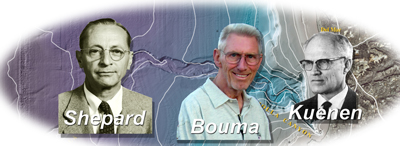
Very Short Historical Overview of Deepwater Clastic SedimentsOur current understanding of deepwater sediments owes much to the intertwined careers of Phillip Henry Kuenen, Francis Parker Shepard and Arnold Bouma. Prior to the Second World War geologist’s understanding of the stratigraphy and occurrence of deeper water sediments was poor. This changed with the pioneering work of Kuenen of Groningen University with the Snellius expedition to the Dutch East Indies 1929-1930 (Kuenen 1937 and 1938) and his following work with outcrops and flume (Kuenen, & Migliorini, 1950; Kuenen, 1951). Concurrently Shepard of the Scripps Institute of Oceanography developed an understanding of sedimentation from the shoreline across the continental shelf and down the slope via submarine canyons to the fans (Shepard, 1948). Interestingly though more focused on shallow water geology Shepard’s contributions to our understanding of deepwater cayons came from his career taking summer vacations yachting off the east coast of the USA, his experiences during the Second World War when he worked as principal geologist for the University of California Division of War Research from 1942-1945 and his later work at the Scripps Institution of Oceanography.
Arnold Bouma stormed into this scene changing our understanding of deepwater systems for ever. His education was shaped by rural schooling, when at the age of 11, during the Second World War, he was sent by his father, a member of the Dutch Resistance movement against the Nazis, to the country to work as a farm hand on his uncle's land milking cows. As a teenager he was befriended by the local museum curator who helped him when he visited the museum to learn about Rocks, fossils and minerals. She introduced him to the local gravedigger who helped Arnold understand the Rock record and when he helped dig graves they would both look at the shallow stratigraphy of that location. Arnold learnt how to clean the sediment exposed in the sides of the grave pits, learning more about the order of the deposition of the sediment. He and the grave digger also amassed an amazing collection of Rocks, extending their local reputation. Arnold remembers his engineer father as a nervous man who angrily remonstrated with him when he took interest in a trench dug by a workman involved with building a bridge under the direction of his father.
Arnold went on to Groningen University as an undergraduate and worked as Kuenen's lab assistant and helping with his now famous flume experiments in the generation of graded beds from turbidites. He also measured the rates at which cobbles were rounded. Arnold then entered the Dutch Army to spend time in Germany as a surveyor. When he left the army Arnold then enrolled as a graduate student at Utrecht to earn his M.S. degree in geology, sedimentology and paleontology in 1959 and a Ph.D. in sedimentary geology under Professor D.J. Doeglas in 1961. As a graduate student Arnold continued to sit in the outer office of Kuenen’s lab and at Kuenen’s prompting studied the Arnot Sandstone in the South of France. In 1962, he acquired a Fulbright post-doctoral fellowship to work with Shepard at the Scripps Institute of Oceanography in La Jolla, California. Here he met with Bob Dill who introduced him to diving in the submarine canyon off La Jolla. Arnold worked with the ideas of Kuenen and Shepard and the results of his field work in the Annot-Peria-Cava areas of southern France, proselytizing the importance to turbidites and the deepwater setting in which they accumulate (Bouma,1959a&b; Bouma, 1962).
In the mid sixties in addition to turbidity currents, concepts of deep-marine bottom currents in modern oceans became popular when Heezen et al. (1966) reported deep-water masses that flow along the ocean floor, popularly known as “thermohaline-induced geostrophic bottom currents” or “contour currents”. Their deposits are called “contourites” (Hollister, 1967).
References Cited
Bouma, A. H. 1959a. Some data on turbidites from the Alpes Maritimes, France. Geologie en Mijnbouw, 21, 223–227.
Bouma, A. H. 1959b. Flysch Oligocène de Peïra-Cava (Alpes-Maritimes, France). Eclogae Geologica Helvetica, 51, 893–900.
Bouma, A. H., 1962, "Sedimentology of some flysch deposits, a graphic approach to facies interpretation", pp 168; Amsterdam: Elsevier
Gill, W. D., and Kuenen, P. H. 1958, Syndepositional sliding and slumping in the West Clare Namurian basin, Ireland. Geol. Surv. Irel., Spec. Pub. 4, 1-121.
Heezen, B.C., Hollister, C.D., Ruddiman, W.F., 1966. Shaping of the continental rise by deep geostrophic contour currents. Science 152, 502-508.
Hollister, C.D., 1967. Sediment distribution and deep circulation in the western North Atlantic. Ph.D. dissertation. Columbia University, New York, p. 467 (unpublished).
Kuenen, Ph. H. 1937. Experiments in connection with Daly’s hypothesis on the formation of submarine canyons. Leidshe Geol. Mededeelingen, 7(Dl), 327–351.
Kuenen, Ph. H. 1938. Density currents in connection with the problem of submarine canyons. Geological Magazine, 75, 241–249.
Kuenen, Ph. H. & Migliorini, C. I. 1950. turbidity currents as a cause of graded bedding. Journal of Geology, 58, 91–127.
Kuenen, Ph. H. 1951. Properties of turbidity currents of high density. In: Hough, J. L. (ed.) turbidity currents and the Transport of Coarse Sediments to Deep Water, Society of Economic Paleontologists and Mineralogists, Special Publication, 2, 14–33.
Kuenen, Ph H, 1957, "Sole markings of graded graywacke beds", Journal of Geology, 54, 120-147
Kuenen, P.H., 1968. So-Called turbidite Structures. Journal of Sedimentary Petrology, Vol. 38, No3, p. 943-957.
Shepard, Francis Parker (1948) Submarine Geology, Harper’s, New York